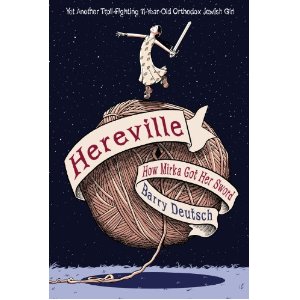 Review written by Jessica Banks.
Review written by Jessica Banks.
Hereville: How Mirka Got Her Sword is a graphic novel that tells the story of Mirka, a feisty eleven year old with a head full of heroic aspirations of dragonslaying and adventuring. What makes Mirka different from all the other girls is her context—she lives in Hereville, a town populated entirely by Orthodox Jews. Hereville feels suspended in time; their house has electricity, but neither cars nor computers show up, and as kids, Mirka and her siblings walk everywhere they need to go.
One day, Mirka gets turned about after confronting the bullies who always pester her younger brother, and when she stumbles out of the woods, she finds herself in front of a huge Victorian house she’s never seen before. The house is home to a witch with a magical garden, and when Mirka steals a grape, the witch transforms into a pig to torment her. Mirka later saves the witch-pig, earning a favor, which she trades for knowledge of the location of a real monster she can slay—a troll, from whom she wins a sword, just like the heroes in her stories.
While the story is as funny and clever as Mirka herself, what makes this book different is how the author sets a pretty common character in modern fantasy—the adventurous girl with dreams of the world beyond her boundaries—in a completely new context. Mirka isn’t in some distant land, or back in medieval times, or in an imaginary world. The Orthodox community of Hereville is matter-of-factly portrayed, and the reader learns about it just as we would learn about the geography and mores of a new fantasy setting.
SPOILER ALERT: Things you might want to know before suggesting this to your kid
Romance/Marriage
One of Mirka’s sister refers to their 18-year-old sister, who’s the subject of meetings with the matchmaker, and that if the family reputation is damaged by Mirka’s hijinks, their sister could end up with someone who wouldn’t treat her well.
Stereotypes
Mirka’s a bit of a square peg in a round hole, a feeling which almost everyone can sympathize with, but her particular round hole has moral and religious boundaries in addition to social pressures. She breaks rules in a number of different ways throughout the story, and it’s interesting to see which ones she chooses to transgress and why. Mirka also talks about the factions among the girls at school—the square, the loser, the cool girl—but the standards adhere to their Orthodox values, not secular ones. Kids might be prompted to examine what values underlie the social rankings in their own environments.
Death
Mirka’s mother died at some point in the past, and Mirka feels her mother’s presence at a moment of danger, prompting questions about the afterlife.
Religion/theology
Mirka’s whole world is bounded by the rules of Orthodox Judaism. Kids will notice that the characters dress and wear their hair differently. We see her family prepare for and celebrate Shabbos (the Sabbath). We see her in school, in the gender-segregated classrooms and cafeteria. We hear her talking with her siblings and friends, their dialogue sprinkled with Yiddish phrases (all footnoted, never overdone to the point of obscuring meaning). This book will likely raise questions about religion—why people do what they do, why others do things differently—but it’s a great starting place for the discussion.*
Violence & Scary Parts
The witch turns into a pig that looks downright scary in some panels, and Mirka almost drowns in her battle with it. She wins her sword by confronting a troll that looks very different from the standard European mythological under-the-bridge sort (this one’s more spider-like). Two older boys bully Mirka’s younger brother, but Mirka fights back against them on several occasions.
Family
Adults are largely absent from the story, but Fruma, Mirka’s stepmother, is a sensitive, complex character, and Mirka’s understanding of her grows as events advance. Fruma and Mirka argue frequently, even changing sides of the argument without losing any of their passion—a respected tradition in Jewish culture that comes from centuries of examining every possible facet of the laws in Scripture.
Mirka’s relationship with her siblings is typically fractious, but they stick together when outside challenges present themselves. The family seems warm and encompassing in the scenes surrounding the Sabbath celebration.
Recommendation
The art style is very accessible, similar to Charles Schultz (Peanuts) and Walt Kelly (Pogo), and reluctant readers may get drawn in more readily by the lively graphics than they would by an all-text book. The dialogue is smart but not difficult for a nine or ten year old. It’s a fast read for an adult, so I’d suggest that both parent and kid read it. And, despite the fact that Mirka’s a girl, her adventurous nature and her preoccupation with heroes and monsters makes the story appealing to boys, too.
* If you want to learn more about Judaism so you can answer your child’s questions, here are a few additional resources:
- Judaism 101: http://www.jewfaq.org/index.htm
- ReligionFacts overview of Judaism: http://www.religionfacts.com/judaism/fastfacts/overview.htm
- United Religions Initiative—Kids’ Facts about Judaism: http://www.uri.org/kids/world_juda.htm
And of course, there are few better sources for a quick overview of any topic than a good nonfiction book aimed at kids, such as DK Eyewitness Books: Judaism.
Hereville: How Mirka Got Her Sword by Barry Deutsch
Published in 2010 by Amulet Books
A sequel, Hereville: How Mirka Met a Meteorite, will be published in November, 2012.
Hardcover graphic novel





Speak Your Mind